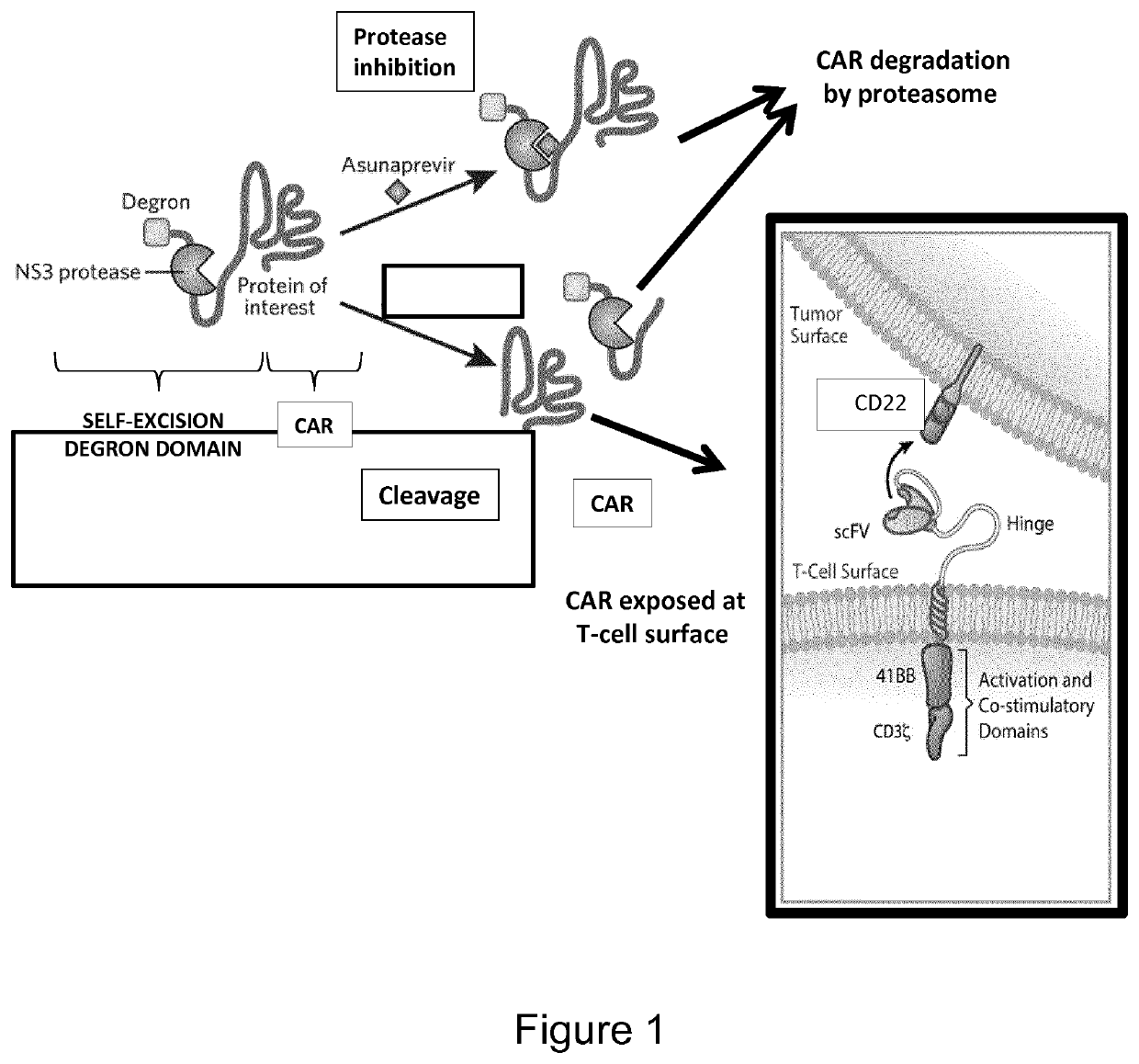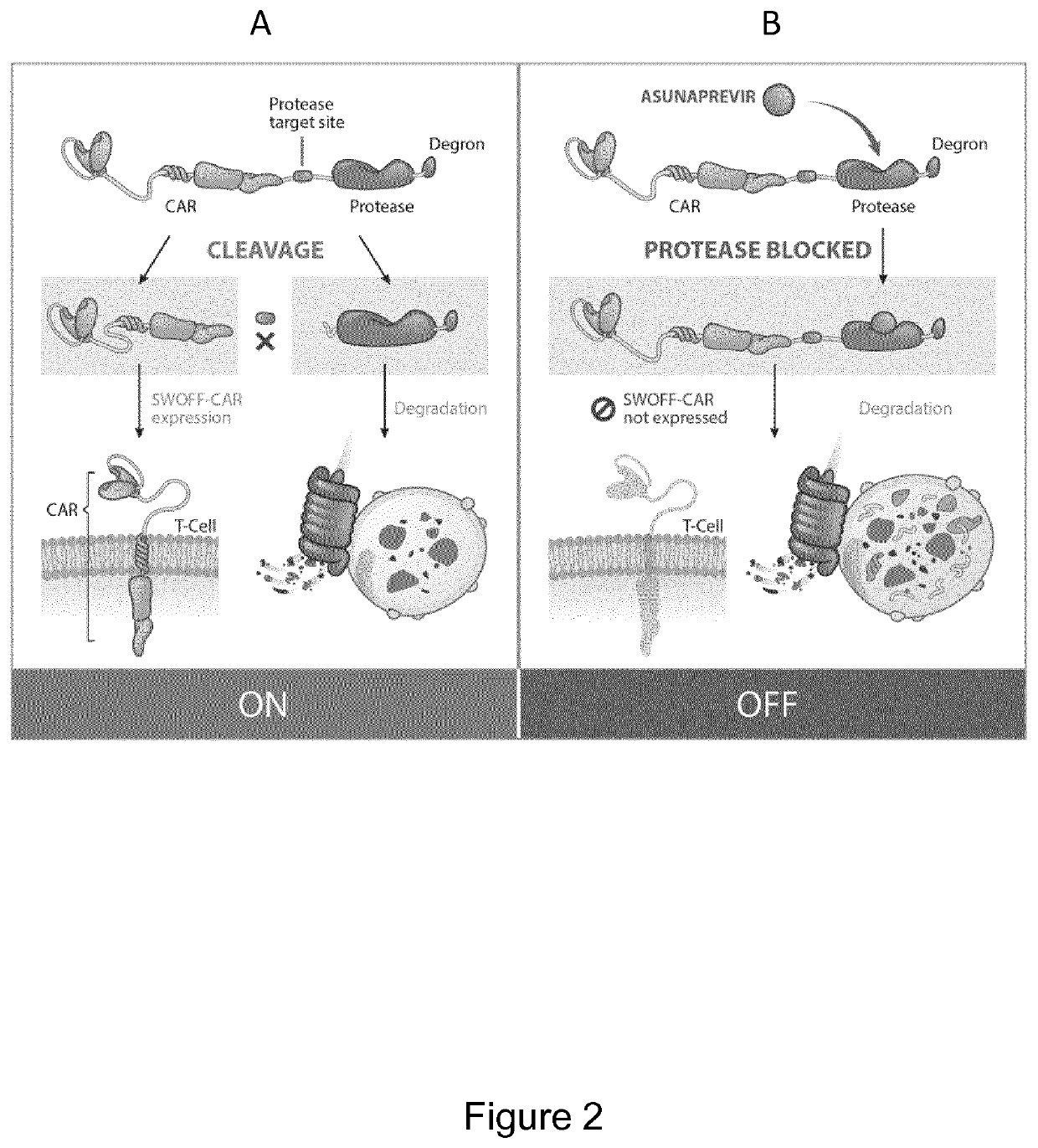Protease based switch chimeric antigen receptors for safer cell immunotherapy
- Summary
- Abstract
- Description
- Claims
- Application Information
AI Technical Summary
Benefits of technology
Problems solved by technology
Method used
Image
Examples
example 1
[0209]Polynucleotide sequences have been assembled into lentiviral vectors in view of transducing primary T-cells expressing CARs with small molecule based degradation properties.
[0210]Lentiviral Vectors Encoding CARs with C-Terminal Small Molecule Based Controlled Degradation Moiety
[0211]CARs have been designed comprising a self-excising degron as per the following structure (from N to C-terminus):
[0212](1) a signal peptide for targeting to the cell surface derived from the T-cell surface glycoprotein CD8 alpha chain (SEQ ID NO: 21),
[0213](2) an antigen binding domain (ScFv) respectively derived from anti-CD123 and anti-CD22 antibodies (SEQ ID NO: 22 and SEQ ID NO: 23),
[0214](3) a stalk (or hinge) domain derived from the T-cell surface glycoprotein CD8 alpha chain (SEQ ID NO: 24),
[0215](4) a transmembrane domain derived from the T-cell surface glycoprotein CD8 alpha chain (SEQ ID NO: 25) and
[0216](5) an intracellular domain (SEQ ID NO: 26) comprising itself a co-stimulation moiety ...
example 2
[0238]Characterization of Surface Expression of C-Terminal Fusion CARs in Primary Human T-Cells
[0239]Peripheral blood mononuclear cells (PBMCs) were thawed and plated at 1×106 cells / ml media in X-vivo-15 media (Lonza cat # BE04-418Q) supplemented with 5% AB serum (Seralab cat # GEM-100-318) and 20 ng / ml IL-2 (Miltenyi Biotech cat #130-097-748) for overnight culture at 37° C. PBMC were activated using human T activator CD3 / CD28 (Life Technology cat #11132D) in X-vivo-15 media supplemented with 5% AB serum and 20 ng / ml IL-2.
[0240]1×106 activated PBMCs (in 600 μl) were immediately incubated upon activation without removing the beads in an untreated 12 well plate pre-coated with 30 pg / mL retronectine (Takara cat # T100B) in the presence of the lentiviral particles prepared in Example 1 encoding the degron CARs for 2 h at 37° C. 600 μl of 2× X-vivo-15 media (X-vivo-15, 10% AB serum and 40 ng / ml IL-2) is then added and the cells were further incubated at 37° C. for 72 h. 3-5 days post tra...
example 3
[0242]Characterization of Cytolytic Properties of C-Terminal Fusion Degron CARs in Primary Human T-Cells by Addition of Asunaprevir Protease Inhibitor
[0243]PBMCs are thawed and plated at 1×106 cells / ml media in X-vivo-15 media (Lonza cat # BE04-418Q) supplemented with 5% AB serum (Seralab cat # GEM-100-318) and 20 ng / ml IL-2 (Miltenyi Biotech cat #130-097-748) for overnight culture at 37° C. PBMCs were activated using human T activator CD3 / CD28 (Life Technology cat #11132D) in X-vivo-15 media supplemented with 5% AB serum and 20 ng / ml IL-2. 1×106 activated PBMCs (in 600 μl) were immediately incubated upon activation without removing the beads in an untreated 12 well plate pre-coated with 30 pg / mL retronectine (Takara cat # T100B) in the presence of lentiviral particles encoding the engineered CARs of example 1 for 2 h at 37° C. 600 μl of 2× X-vivo-15 media (X-vivo-15, 10% AB serum and 40 ng / ml IL-2) was then added and the cells are incubated at 37° C. for 72 h. Transduced T-cells (1...
PUM
| Property | Measurement | Unit |
|---|---|---|
| Current | aaaaa | aaaaa |
| Fraction | aaaaa | aaaaa |
| Degradation properties | aaaaa | aaaaa |
Abstract
Description
Claims
Application Information
 Login to View More
Login to View More - R&D
- Intellectual Property
- Life Sciences
- Materials
- Tech Scout
- Unparalleled Data Quality
- Higher Quality Content
- 60% Fewer Hallucinations
Browse by: Latest US Patents, China's latest patents, Technical Efficacy Thesaurus, Application Domain, Technology Topic, Popular Technical Reports.
© 2025 PatSnap. All rights reserved.Legal|Privacy policy|Modern Slavery Act Transparency Statement|Sitemap|About US| Contact US: help@patsnap.com



